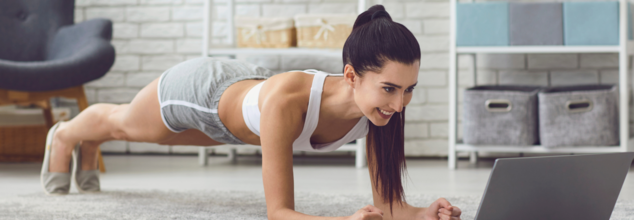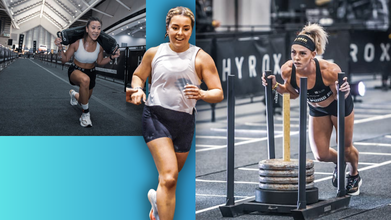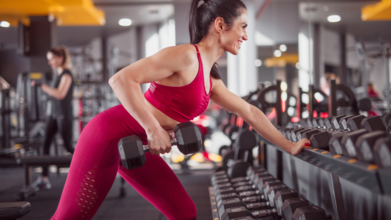- Health Conditions A-Z
- Health & Wellness
- Nutrition
- Fitness
- Health News
- Ayurveda
- Videos
- Medicine A-Z
- Parenting
- Web Stories
Low Budget Workout: Floor Workouts To Do At Home

Home Workout (Credit-Canva)
Getting a gym membership is a commitment, not many people are willing to invest in. There are many effective floor workouts that offer a variety of exercises that can help you build strength, improve flexibility, and boost your confidence. Whether you're a beginner or a seasoned athlete, these exercises are suitable for all fitness levels. With just a little bit of space and a few household items, you can create a challenging and effective workout routine right in your own home. Try incorporating these exercises into your daily routine and see the results for yourself.
Remember to warm up before your workout and cool down afterwards. For added variety, try combining these exercises into different workout routines. You can also adjust the number of repetitions and sets to suit your fitness level and goals.
Exercises You Should Try
In today's fast-paced world, finding time for exercise can be a challenge. However, with a little creativity and determination, you can achieve your fitness goals without leaving the comfort of your own home
Push-ups
A classic exercise that targets your chest, shoulders, and triceps. Start by performing push-ups on your knees and gradually progress to full push-ups as you get stronger.
Crunches
Work your abdominal muscles with this simple yet effective exercise. Lie on your back with your knees bent and your hands behind your head. Lift your upper body towards your knees, engaging your core muscles.
Chair Dips
Use a sturdy chair to target your triceps. Sit on the edge of a chair with your hands gripping the edge beside your your elbows are bent at a 90-degree angle.
Planks
Engage your core, shoulders, and legs with this isometric exercise. Get into a push-up position and hold, keeping your body straight and your core engaged. This exercise is excellent for improving core strength and stability.
Step-ups
Use a step or a sturdy box to work your legs and glutes. Step up onto the platform with one leg and then the other, alternating legs with each repetition.
Squats
Strengthen your legs and glutes with this fundamental exercise. Stand with your feet shoulder-width apart and lower your body as if sitting down. Keep your back straight and your knees aligned with your toes.
Book Bag Squats
Fill a backpack with books or weights and squat to increase resistance. This exercise is a great way to add resistance to your workouts without additional equipment. Simply fill a backpack with heavy objects and squat as you normally would.
Lunges
Target your quads, hamstrings, and glutes with this compound exercise. Step forward with one leg and lower your body until both knees are bent at a 90-degree angle. Keep your upper body upright and your weight balanced evenly on both legs.Towel Slides
Use a towel to create a sliding surface for dynamic core and leg exercises. Place a towel on a smooth floor and get into a plank position with your hands on the towel. Slide your hands forward and back, engaging your core and legs.
Not Just A Workout, Why Everyone’s Training For HYROX Now?

Credits: Hyrox.com
Walk into any major city gym today, and you’ll hear it in the buzz: “HYROX ready.” It’s not just a fitness sprint—it’s a culture shift. What started in Germany in 2017 as a geeky concept for “everyday exercisers alongside elite athletes” has rapidly become a global force (with over 650,000 competitors worldwide in 2024). So, what’s driving people out of their usual classes and across the finish line of a fitness race that demands as much grit as a mini-triathlon?
HYROX bridges two worlds- the clarity of a structured endurance event and the grit of functional strength training. Participants complete eight 1-kilometer runs—interspersed with ski ergs, sled pushes and pulls, burpee broad jumps, rowing, farmer’s carries, sandbag lunges, and wall balls. It’s measurable, repeatable, and inclusive—and that formula is winning hearts.
Born in Germany in late 2017, HYROX emerged from a simple yet bold idea: create a fitness competition that anyone—from the everyday exerciser to the elite athlete—could tackle. Founders Christian Toetzke and Moritz Fürste designed an event balancing accessibility with athletic rigor. They intentionally eliminated high-skill or high-risk movements like box jumps or monkey bars, choosing exercises rooted in natural human movement. The result: a standardized format—eight functional stations broken up by one-kilometer runs—held indoors, globally consistent, and universally fair.
In a world of fitness-at-the-fringes where “functional fitness” isechoed on TikTok and in diets—HYROX fills a need. It’s not about sculpted muscles or Instagram-worthy yoga poses. It’s about real-world physicality: pushing, pulling, lifting, carrying—then running. Fitness expert and Leading Indian Triathlete Deepak Raj, captures it, “HYROX is the World Series of Fitness… combining functional strength and cardiovascular endurance”. No wonder gym floors are buzzing with “finishers’ patches” and talk of “my next HYROX.”
That desire for holistic fitness is more than vanity it’s about confidence in everyday strength. If you can run 8 km, push a sled, lift a sandbag—and keep going you’ll feel it in your bones.
A standard HYROX race alternates physical tasks with running, validating both power and endurance. Each athlete covers:
- 1 km run
- 1,000 m Ski Erg (upper body and core)
- 1 km run
- 50 m sled push, followed by sled pull
- 1 km run
- 80 m burpee broad jumps
- 1 km run
- 1,000 m rowing
- 1 k
- 200 m farmer’s carry
- 1 km run
- 100 m sandbag lunges
- 1 km run
- 100 wall balls to finish
Competitive divisions- Open or Pro, Singles, Pairs, or Relay—cater to all fitness levels. The average finisher clocks around 90 minutes; elite athletes break 60 minutes, with world records just dipping into the 50-minute range.
What’s Fueling the HYROX Boom?
Participants no longer chase only aesthetics. Functional strength—lifting, carrying, running—is today’s measure of fitness. HYROX provides that holistic test in a tangible package. Race day gives meaning to hours in the gym. It’s a finish line against your own potential or against global peers.
With standardized format and inclusive categories, HYROX strips away elitist barriers and invests in community support—solidarity through struggle. COVID taught us that wellness needs structure and connection. HYROX provides both in one race—physical demand paired with social engagement. Certified coaches, programming apps, and recovering protocols make training smart and safe. Whether tackling a sled or pacing your fifth kilometer, expert guidance keeps participants moving confidently.
If you scroll through Hyrox’s global social feed, you’ll see 75-year-olds crossing finish lines side by side with 25-year-olds.
1. The Desire for Holistic Fitness
More people want to be not just lean or muscular, but truly “fit for life.” HYROX’s hybrid format pushes participants to build strength, endurance, mobility, and mental resilience, fostering functional fitness that translates to everyday energy and confidence.
2. The Power of “Event Motivation”
Goal-oriented training is a proven driver of consistency. With HYROX setting tangible targets, whether finishing, setting a personal best, or qualifying for the World Championship, enthusiasts of all ages are finding newfound motivation to show up, train smart, and push their own boundaries.
3. Accessibility and Community
Unlike ultra-endurance or niche sport events, HYROX is designed for all fitness levels. Its team, doubles, and mixed relay formats encourage friends, families, and coworkers to participate together, breaking down barriers and building thriving, supportive communities both online and offline.
4. Post-pandemic Wellness Shift
The pandemic reinforced health as a daily priority. Indians, especially urban professionals are investing more in preventative wellness, looking for platforms like HYROX that offer both structured challenge and supportive social engagement.
5. Expert-Led Training Ecosystem
With certified trainers, nutrition experts, and digital guidance widely available, aspiring participants feel empowered to safely prepare for their first (or fastest) HYROX. This ecosystem created by Hyrox India demystifies the process, minimizes injury risk, and maximizes result-driven training.
Those who train for HYROX don’t just lean up—they gain lung capacity, metabolic strength, mental grit, and a community that applauds finishing over fancy. As Deepak who has ran the IRONMAN competition puts it, “‘HYROX ready’ signifies more than fitness. It reflects personal growth through sport, functional ability, and achievement with others”.
Let’s say you sign up for a race with your friends. You train together, share meals and regrets and splits. On race day, the music blares like a mini-rave, volunteers chant your name, and strangers cheer you on. You cross the line, sweaty and spent—and you’re welcomed like you’ve returned home.
What Does “HYROX Ready” Mean for Health?
Mr Deepak adds, "HYROX has started a fitness movement and the buzz around being HYROX Ready reflects a meaningful movement, one where fitness is not a fad, but a lifestyle. It signifies the value Indians now place on functional ability, community achievement, and personal growth through sport. As more people embrace HYROX, we see a positive ripple effect: healthier hearts, stronger bodies, sharper minds, and a sense of belonging. If the current momentum is any indication, “HYROX ready” will soon become shorthand for holistic, all-round fitness, setting a new benchmark for people's health journey and Hyrox becoming a big fitness event”
Fitness is no longer about chasing Instagram angles. It’s about chasing health, connection, and purpose and HYROX offers all three. You are training for life, with markers, support, and challenge that demand more than a T-shirt and squat rack allows.
Deepak Raj, fitness expert, Leading Indian Triathlete, IRONMAN 70.3 Goa and CEO, Yoska, Country Head and Race Director at HYROX India
Can Exercising Help Prevent Cancer? Study Says It Cuts Risk By 30%

Credits: Canva
Just one bout of physical activity, specifically resistance training or high-intensity interval training (HIIT) may trigger a measurable anti-cancer response in the body. That’s not wishful thinking. It’s the takeaway from a compelling new study by researchers at Edith Cowan University (ECU) in Australia, who found that a single workout could slow the growth of cancer cells by as much as 30%.
While exercise has long been considered a complementary therapy in cancer care, this study sharpens the focus. It suggests that even short-term, intentional movement could offer physiological benefits for breast cancer survivors at the cellular level. And that’s a big deal.
Led by PhD researcher Francesco Bettariga, the ECU study explored how exercise impacts breast cancer survivors not just in the long term, but immediately. The team zeroed in on myokines, which are proteins secreted by muscles during exercise. Myokines are emerging as powerful players in the body’s defense system, with proven anti-inflammatory and anti-cancer effects.
Participants in the study—all breast cancer survivors underwent either a single session of resistance training or HIIT. Researchers then measured their blood before, immediately after, and 30 minutes post-exercise. The results showed a clear and consistent increase in myokine levels across both workout formats.
This spike wasn’t just theoretical. Bettariga’s lab data indicated that these boosted myokine levels could reduce the rate of cancer cell growth by 20–30%, after just one session.
Why It Is More Important for Breast Cancer Survivors?
We already know that cancer—and the treatments used to fight it—can wreak havoc on the body’s immune system and metabolism. Fatigue, inflammation, muscle loss, and long-term damage to cellular function are all common side effects. That’s part of what makes this study so significant: it demonstrates that even bodies under considerable strain from cancer treatment can still mount a biological defense through exercise.
“The results from the study show that both types of exercise really work to produce these anti-cancer myokines in breast cancer survivors,” Bettariga noted. “The implications are powerful—this is strong motivation to integrate exercise into cancer care.”
What’s unique here is the immediacy. Most studies emphasize the long-term benefits of exercise over weeks or months. This one highlights a biochemical response that kicks in within minutes.
Link Between Inflammation And Body Composition?
Beyond myokines, the study also looked into another critical component of cancer recurrence: inflammation.
Persistent inflammation plays a major role in tumor progression. It promotes the survival and spread of cancer cells and suppresses the immune response, making it harder for the body to fight back. Worse, both cancer and its treatments can increase inflammatory biomarkers in the bloodstream.
According to Bettariga’s extended research, the answer lies in body composition—specifically, reducing fat mass and increasing lean muscle through consistent exercise.
“Strategies are needed to reduce inflammation,” he said, “which may provide a less supportive environment for cancer progression, leading to a lower risk of recurrence and mortality in survivors of breast cancer.”
Building lean muscle through resistance or interval training doesn’t just make you stronger. It could actually help change the biochemical environment of your body to be less hospitable to cancer cells.
Why Diet Alone Isn’t Enough?
The study also underscores an important caveat: quick-fix weight loss strategies don’t deliver the same benefits. In fact, losing weight without preserving or building muscle may do more harm than good.
“You never want to reduce your weight without exercising,” Bettariga cautioned. “You need to build or preserve muscle mass and produce these beneficial chemicals—like myokines—that you can’t get through diet alone.”
That means crash diets, juice cleanses, or calorie-cutting without movement won’t contribute meaningfully to the anti-inflammatory or anti-cancer response. The muscle is the medicine in this case—and it has to be activated.
How to Add HIIT or Resistance Training into Your Routine?
If this all sounds powerful but overwhelming, start simple. The study wasn’t testing elite athletes. It was studying real breast cancer survivors, many of whom were new to structured exercise routines. For resistance training: Think compound movements that target large muscle groups—like squats, lunges, push-ups, or lifting light weights. You don’t need a gym or equipment to start. Even bodyweight training done consistently can build lean mass.
For HIIT, try alternating 30 seconds of high-effort movement (like jumping jacks, stair climbs, or brisk uphill walking) with 1–2 minutes of slower recovery. Repeat the cycle for 15–20 minutes.
The key isn’t the duration, it’s the intensity and consistency. According to Bettariga’s findings, even one session is enough to jumpstart the body’s internal defense mechanisms.
Can This Improve Future of Cancer Care?
There’s a growing shift in how we view recovery and survivorship. No longer is exercise considered a “bonus” or “optional.” Increasingly, it’s being recognized as a core component of medical care—one that can potentially alter the trajectory of disease, especially in cancers with high recurrence rates like breast cancer.
While more research is needed to explore the long-term implications of myokine production and its effect on cancer recurrence, the current data is promising. At a time when many cancer survivors are looking for ways to reclaim control over their bodies, this study offers something rare: a simple, immediate action that can make a real difference.
Strength Training The Right Way - How To Do Dumbbell Rows Properly

(Credit-Canva)
It is very easy to do exercises wrong, especially strength exercises. The reason why one must be careful when they are doing weights is because you could end up overexerting one certain muscle and not get the results you wanted. One such exercise is dumbbell row.
Sitting at a desk all day or focusing on "pushing" exercises like bench presses can lead to rounded shoulders and back pain. Dumbbell rows are a "pulling" exercise that helps balance your body. They strengthen your back muscles, which can improve your posture and reduce common aches and pains from daily life.
How to Do a Dumbbell Row
Dumbbell rows are a simple yet effective exercise. Here's a step-by-step guide to doing them correctly:
- Place a workout bench in front of you. Stand with your feet about shoulder-width apart.
- Steady yourself by putting your right hand on the bench. Pick up a dumbbell with your left hand.
- Keep your back straight, creating a diagonal line from your head to your hips. Your shoulders should be slightly higher than your hips.
- Keeping your left arm close to your body, pull the dumbbell straight up toward the ceiling. Your spine should stay completely still—only your arm and shoulder should move.
- Slowly and with control, lower your arm back down to the starting position.
Tips for Perfect Form
Even though dumbbell rows seem easy, paying close attention to the details will help you get the best results and avoid injury. To prevent straining your neck, keep your head still and look at a spot on the floor about three feet in front of you. It’s also a good idea to start with your weaker arm first so you can give it your full attention when you have the most energy.
Focus on your breathing. Inhale before you pull the weight up, then breathe out as you pull. Or, you can hold your breath as you pull and breathe out at the top or on the way down. This helps keep your core stable. When choosing a weight, start with a lighter one and work your way up. The last repetition should be difficult, but not so heavy that you have to swing your whole body to lift it. You can also slightly change the angle of your elbow to target different back muscles.
Muscles Worked by Dumbbell Rows
Dumbbell rows are great for building strength in your mid and upper back. This exercise targets several important muscles, including your lats which is the large muscles that keep your back stable and help your shoulders move, your traps which are the muscles in your neck and upper back that help move your head and maintain good posture, and your rhomboids, the upper back muscles that help stabilize your shoulders.
Back pain is one of the most common reasons people see a doctor. By adding dumbbell rows to your workout, you can strengthen the muscles in your back and build better posture. This can lead to less back pain, a stronger core, and an improved range of motion.
Dumbbell rows can be a fantastic part of your fitness routine. However, if you have any health concerns, recent injuries, or long-term medical conditions, it's always a good idea to talk to a doctor or physical therapist before you start a new exercise.
© 2024 Bennett, Coleman & Company Limited

